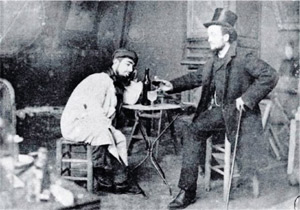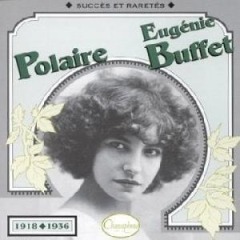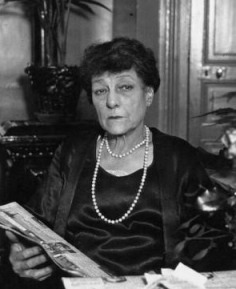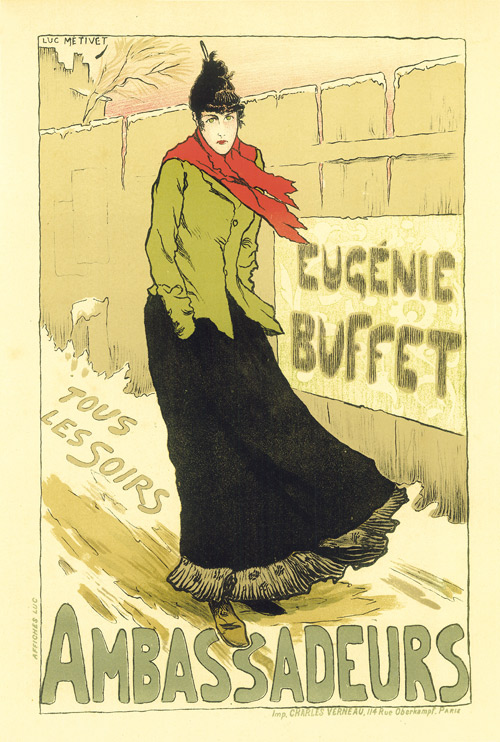Ambassadeurs, Eugénie
Buffet, 1893
VINTAGE FRENCH POSTER - GICLÉE
PRINT
This example of "Affiche Artistique" is titled
"Ambassadeurs - Eugénie
Buffet", by the artist Lucien Métivet, published
in 1893.
Dimensions: 16" x 24"
|
Item# |
Title |
Choose: |
Shp Wt |
Price |
Click to buy |
|
1W-ART-005-1 |
Ambassadeurs, Eugenie Buffet, 1893 |
Archival Paper |
2 lbs. |
$29.95 |
Add to Basket |
|
1W-ART-005-5 |
Ambassadeurs, Eugenie Buffet, 1893 |
Repositionable Peel & Stick Fabric* |
2 lbs. |
$39.95 |
Add to Basket |
|
*Peel & Stick: Repositionable
self-adhesive fabric that resists water, wrinkles and tears.
Can be repositioned with ease without damaging walls. No
need for screws, tape or push-pins, simply peel and stick. |
Artists in the late 1800s found
opportunities to present their work to the masses through advertising art
that began to appear as billboards and posters, plastering the streets of
Paris. “Affiche Artistique” was the term that the French used to describe a
poster that contained artistic expression. The art was so impressive
to the public, people began to collect the posters as soon as they went up,
which is why they are so scarce today. Artists such as Henri
Toulouse-Lautrec, Alphonse Mucha, Jules Chéret, Théophile-Alexandre
Steinlen, Pierre Bonnard and Eugène Grasset contributed to the creative body
of work that became what some called “a free museum for the masses”.
The craze for collecting these examples of modern art was even given the
name, "affichomanie", meaning “artistic poster mania”. Collectors today pay
hundreds, if not thousands for original prints of these rare posters.
We offer these exceptional vintage poster reproductions in
the highest possible print quality. Superior to most reproductions
currently available on the market, our gallery quality prints are suitable
for display in an art gallery or museum. We begin with an ultra high
resolution scan of the original artifact which we leave untouched, leaving
intact the slightly distressed vintage character desirable in a collectible
piece of this era. Our state of the art, giclée reproduction process
uses the latest technology: microscopic droplets of ink that render such a
high resolution, that every minute detail of the original is intact.
Every pen line and brush stroke is visible. Even very faint pencil
lines are also visible due to the incredibly high quality of the
reproduction process. Our 8 color, archival quality inks and giclée
printing process provide the most accurate color reproduction & are proven
to last over a hundred years. Posters are available printed on museum
quality archival paper or on repositionable media that allow you to plaster
your walls with the “Affiche Artistique”, just as they were originally
intended to be displayed.
About the artist:
Lucien Métivet
French (1863 – 1932?)
Born in Paris, Lucien Métivet became one of the most
prominent illustrators of the 19th century. Métivet studied
classical art before turning his attention to popular art. A talented
cartoonist, he was said to be a master in caricature, humorous illustration
and lithographic techniques.
 While
Métivet’s work appeared in many books and magazines, it was the poster he
created in 1893, promoting the singer/actress Eugénie Buffet’s appearance at
Charles Verneau’s nightclub Ambassadeurs that brought him recognition as a
poster artist. In 1896, Métivet competed with twenty-two other artists
to design a poster depicting Napoleon. Métivet won the competition,
beating Toulouse-Lautrec among others. (Photo of Lucien Métivet and Henri
Toulouse-Lautrec, left). While
Métivet’s work appeared in many books and magazines, it was the poster he
created in 1893, promoting the singer/actress Eugénie Buffet’s appearance at
Charles Verneau’s nightclub Ambassadeurs that brought him recognition as a
poster artist. In 1896, Métivet competed with twenty-two other artists
to design a poster depicting Napoleon. Métivet won the competition,
beating Toulouse-Lautrec among others. (Photo of Lucien Métivet and Henri
Toulouse-Lautrec, left).
Métivet was a contributor to the French humor magazine
“Le Rire” and in 1907, its publisher launched a new magazine, “Fantasio”, to
which Métivet also contributed. Today original illustrations and
posters by Lucien Métivet are highly sought after by collectors.
Singer - Actress
Eugénie Buffet
French Algerian, (1866 – 1934)
 Born
in Tlemcen, Algeria, Marie Buffet knew hardship throughout her early life.
The daughter of a seamstress and soldier, her father died while she was only
six months old. It is unclear when she adopted the name Eugénie, but
she is known to have began acting at age 17, living in Marseilles and
working in the cafés-concerts there. She did not achieve much success
in Marseilles, as it is said she was “booed and hissed off the stage”. Born
in Tlemcen, Algeria, Marie Buffet knew hardship throughout her early life.
The daughter of a seamstress and soldier, her father died while she was only
six months old. It is unclear when she adopted the name Eugénie, but
she is known to have began acting at age 17, living in Marseilles and
working in the cafés-concerts there. She did not achieve much success
in Marseilles, as it is said she was “booed and hissed off the stage”.
The world of Eugénie Buffet changed from rags to riches
in 1886 when she became the mistress of wealthy French count, Guillaume
d’Oilliamson. The count brought Eugénie to Paris and presented her
with a fashionable life.
Eugénie became interested in right-wing politics, and
sang “La Marsellaise” for the nationalists at one of the founding rallies of
the Ligue des Patriotes, winning over many fans among the anti-Dreyfusards.
Eugénie became inspired to portray women of ill-repute
when she saw Aristide Bruant, a cabaret singer who often sang about such
women appearing at Le Chat Noir in 1892. Buffet had experienced some
time in the Prison Saint-Lazare, a detention center for people who had
become an embarrassment to their families. She felt empathy for the
women of the street and studied their habits closely in order to create an
accurate portrayal of their characters.
 Eugénie
Buffet became a star after debuting her character la pierreuse (the
streetwalker) in an 1892 performance at La Cigale in the Quartier Pigalle of
Paris, wearing the signature red scarf and apron that was the mode of dress
for prostitutes at the time. Soon she was in demand and performing in
such famous venues as Théâtre de la Gaîte-Montparnasse, the Théâtre de la
Gaîte-Rochechouart and Les Ambassadeurs. She was also known to
entertain on the streets of poor neighborhoods and coal mines to help raise
money for the homeless. Eugénie
Buffet became a star after debuting her character la pierreuse (the
streetwalker) in an 1892 performance at La Cigale in the Quartier Pigalle of
Paris, wearing the signature red scarf and apron that was the mode of dress
for prostitutes at the time. Soon she was in demand and performing in
such famous venues as Théâtre de la Gaîte-Montparnasse, the Théâtre de la
Gaîte-Rochechouart and Les Ambassadeurs. She was also known to
entertain on the streets of poor neighborhoods and coal mines to help raise
money for the homeless.
During World War I, Buffet performed for the soldiers,
also appearing at the Royal Palace of Brussels. In the 1920s she
toured the United States, Morocco and the Antilles. In 1927 she
appeared as Napoleon’s mother in the silent film “Napoleon”, directed by
Abel Gance.
Édith Piaf portrayed Eugénie Buffet in the 1954 French
musical, French Cancan. |
 |